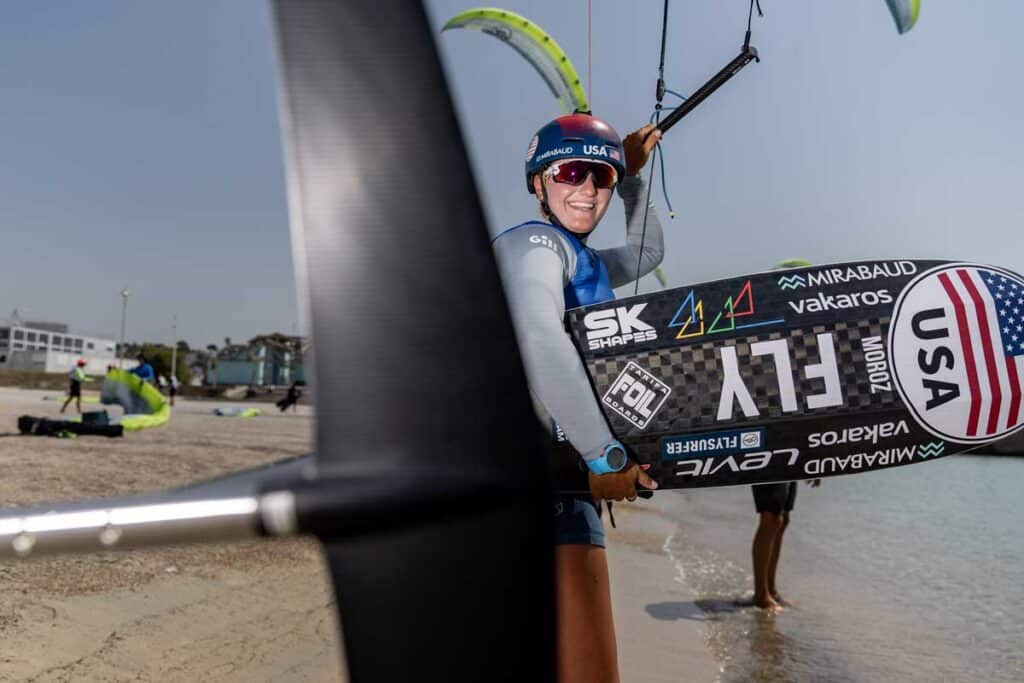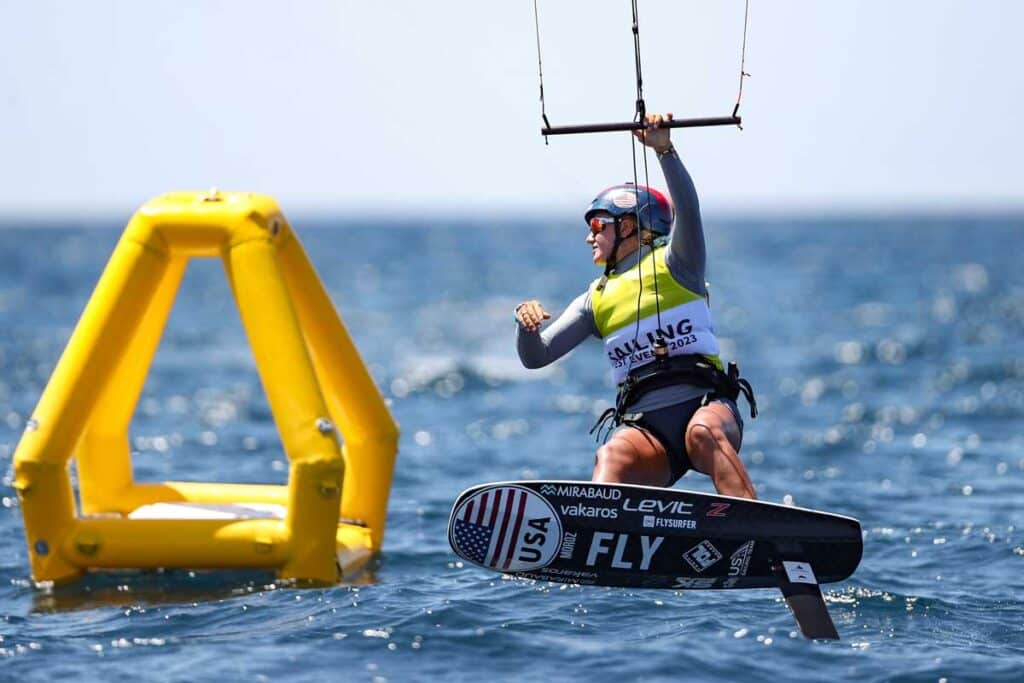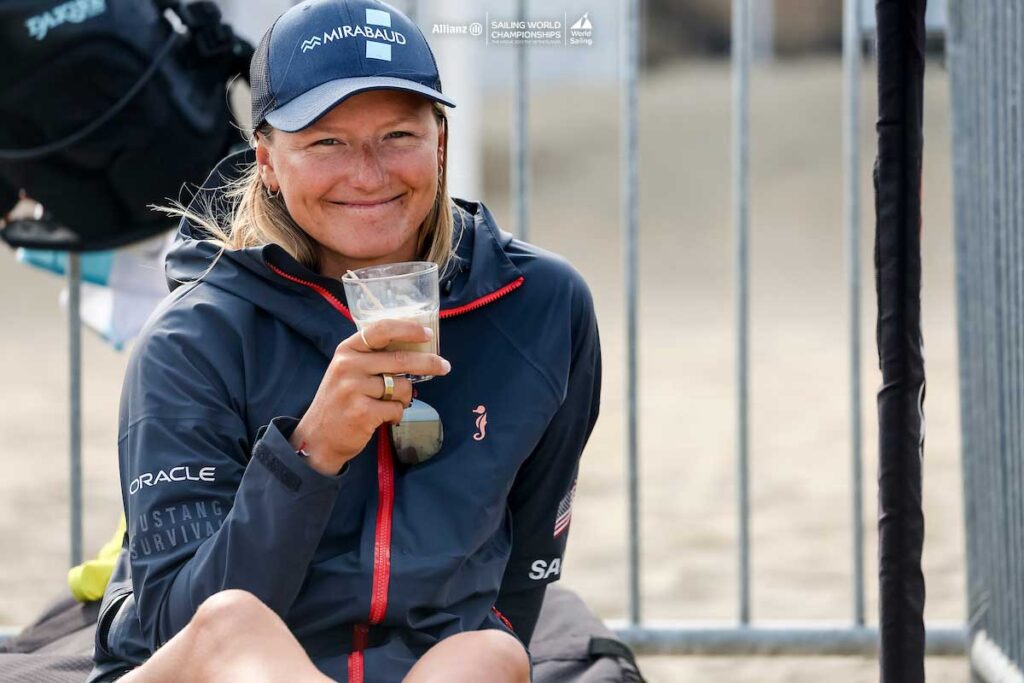
“I was relieved to have officially qualified for the Olympics,” writes Formula Kiteboard champion Daniela Moroz on her excellent and brutally honest blog post. “It’s something I’ve dreamed of my whole life, and it’s crazy to think it’s officially happening – I’m going to be an Olympian. Insane.”
But now comes the hard part. The final push to Marseilles. “There is a lot of work to be done in the next year leading up to the Games,” she writes. “For me, the most important thing will be to keep my head in the right place… there is no off season, no official time where you can recover and disconnect from the job. We think we have to keep training all year, which is completely unsustainable and leads to burnout…
“One of my biggest areas of improvement is gaining weight, so I will be working closely with our awesome team of US Sailing Team trainers based just outside of Miami. I truly believe that following this path will still put out net gains for my Olympic sailing because it will re-spark my fire for the sport. My mission is still clear: the goal is gold, and I’m ready to do everything I can to deliver a winning performance at the 2024 Olympic Games.”
Moroz knows next summer’s Olympic Regatta is not only her first shot at the sport’s first medal, but it could very well be her one and only shot given the emotional and physical drain this campaign has put her through over the past several years at the top of the fleet. There is an underlining urgency in her blog and an honest plea for financial support, which does not come readily from US Olympic coffers. I encourage you to read her latest writing in which she shares the tumultuous experience of her Olympic qualification. She is a legitimate best-medal hopeful for the US Sailing Team, an inspirational sailor that deserves our recognition and support, so let’s all chip in what we can to help her soar to the podium (a GoFundMe pages is now live as well). It’s what she was born to do. The following conversation was recorded at the Helly Hansen Sailing World Regatta Series in Chicago in June ahead of her qualification and published in the Fall 2023 edition of Sailing World Magazine.
—Dave Reed
Born to Soar

There’s a reason why Daniela Moroz, the six-time kiteboard world champion and four-time Rolex Yachtswoman of the Year, is always quick to flash a radiant smile. Happiness comes easy for the 22-year-old foiling phenom from San Francisco, which most certainly has something to do with her parents, her upbringing on, in and now above the water, and the fact that she actually enjoys her training as she pushes ever closer to the Formula Kite’s Olympic debut. “I love pushing myself, and I love seeing how far I can go and how well I can perform,” she says. At the moment, she is performing as expected: fast and faster. In Marseille, France, on the very waters of next year’s Olympic regatta, she won a bronze medal in July and locked in her US Sailing Team spot. All that remains is to qualify the US, and from there it’s straight to the big stage.
Most sailors have likely never watched a kiteboard race. How does it go?
It is course racing, just like what everyone else does in sailing. It’s windward-leeward courses, and it’s a three-minute start sequence. Instead of having an hour- or half-hour-long race, our races are only about 12 to 15 minutes in qualifying [races]. And then eight to 10 minutes in the medal races. It’s really fast. I learned recently that it’s actually the fastest Summer Olympic sport, which is pretty cool. Upwind we’re going 20 to 25 knots, and downwind we’re pushing into the high 30s pretty comfortably. If you want to go fast, it’s a great class to get into. The equipment is unique, and it’s very dynamic and exciting. I always loved going fast, so that was a big thing that pulled me into it.
Describe a typical starting approach; it must be madness with all the kites hovering overhead in one confined area.
It’s similar to regular sailing in that you still have your starting routine—do a few line checks, get a transit, check what side of the course has more wind. Then you’re fighting for position on the line and trying not to come off the foil that whole time. There are kites everywhere and RIBs—there’s a lot going on. Once you start, it’s amazing. I always feel like those first 30 seconds are always so interesting because, while holding a lane, there’s this moment of silence where I get into the flow, and I’m going 20 to 25 knots upwind, and I’m trying to see where I can tack out. Everything is happening at such a fast pace.
What’s the key to being able to hold that lane?
Hiking, which sounds weird for kiting, but that’s what I’m doing. I can be holding up to 120 kilos of load on the board, which transfers into my legs. So, it’s kind of like holding a squat or a wall sit for several minutes upwind. And I just heel over as much as possible. I’m managing all of the power of the kite and kind of putting it into the harness and feeling every little movement to try to point higher and go faster. I’m trying to get the vector from the kite to the board to be as close to 180 degrees as possible.
From there, what are the tactical fundamentals you have to play out while also managing the kite, the foil, and the rest of the fleet?
Speed helps. As always, it’s nice to have a speed edge. When I’m sending into the left corner off the start, I’m always trying to see what my options are. There’s a lot to manage, and I have to get into the flow right away and be conscious of what I’m thinking about and make sure I’m thinking about the right things. In kiting, there’s so much feel that goes into it. The longer you’ve been kiting, the better your field is and the better your reaction times will be to anything that happens with the kite and the foil. The kite and board have to be an extension of your body because you have to be so in sync with it to be able to go fast.

When you started competing in international events and won your first Rolex Yachtswoman of the Year (in 2016 at the age of 15, the youngest winner ever), the field was tiny—no more than a dozen female competitors. But now the numbers and the competitive field are enormous. It’s amazing to think you’ve been at the tip of this spear for so long.
Yeah, it’s really interesting because there’s all these established Olympic sailing classes that have been around forever, so when it comes to the Olympics, there’s kind of a formula. With kiteboarding, we don’t know what the pathway is, and we have to figure it out.
You’ve said recently that your technique is sound, but your next hurdles are the equipment and your weight.
I’ve been kiting for pretty much half of my life now, so my technique is pretty good, my feel is really good, and my boathandling is good. But now it’s a matter of figuring out how to make the most gains and improvements with the equipment. For each regatta, we can have four kites that are different sizes—usually 9, 11, 15 and 21 square meters. We can register only one foil for the whole regatta. I’ve never really been a technical person, and I always blame myself before blaming any of my gear, but now I really have to be more technical and have confidence in my skills and my technique. I know what a fast kite should feel like, and I know how a good foil should feel.
What does a fast kite feel like?
It’s impossible to describe. It just feels good, and it just takes you where you want to go.
What about the weight—is it more advantageous to be heavy or light?
As with almost any foiling discipline, weight is important. In kiting, weight is righting moment, so I’m trying to get as heavy as possible. But it’s hard because I want to feel good and I want to feel strong, fit, agile and athletic, but then I also need to be heavy to just be able to go with that. It’s been an interesting mental challenge because I want to have confidence in my body and what I’m able to do, but it’s not always super easy to do that when you know what our sport demands. It’s an interesting balance, but my goal is to be competing for a medal at the Games, and I’m going to do everything I can that’s in my power to do that.
You’ve been transparent about your burnout a few years ago. What happened?
At the end of the 2019 racing season, I was just starting college and able to take some time off and focus on that. But when I got back on the water and back into kite racing, I didn’t feel that fire in me anymore. It was weird because for so many years all I wanted to do was go kite and go shred and have fun on the water. Suddenly, that desire wasn’t there anymore. That’s not normal. That’s not who I am. When COVID happened and all of the 2020 racing season was canceled, I took six months off, and I remember being at a certain point where I didn’t even want to look at my race gear—I didn’t even let myself keep it in the car so I didn’t even have to think about it. It was probably the best thing I could have done for myself at this point because it had taken this weird toll on me where I didn’t want to do it anymore. The thought of going kiting was so unappealing, which was a really weird feeling to have.
What got you back on track?
I eventually realized kiting is all I’ve really been doing with my life for six years and I needed to have something besides kiting. Because as much as we love sailing and we love foiling, it is not everything in life. You also need to be happy in order to perform, you need to be enjoying what you’re doing, and you need to be connected with your sport and with nature and with what you’re doing. So, I got a Moth.
The vagabond pro-kiter lifestyle must be pretty attractive. You get to play and live in some amazing waters and venues.
Last year, I spent maybe 40 days at home. I’m on the road most of the year. There are downsides to that, but I always remember that I really, really love what I’m doing. And when it comes down to it, I love going out and training actually, and I love pushing myself, and I love seeing how far I can go and how well I can perform. So, I always remind myself that I’m super lucky to get to do this and to even do something I love so much. We get to experience the world in such a unique way that few people get to experience.
Speaking of experiences, what is your top speed to date?
It was around 38 knots—a burst in a bear away, but not before a wipeout.









